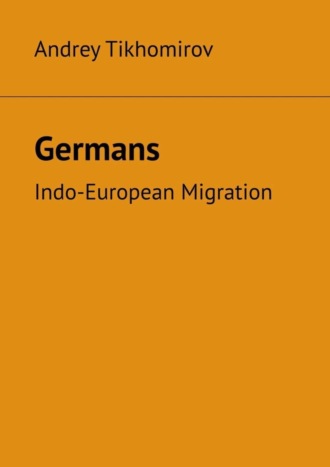
Полная версия
Germans. Indo-European Migration
Judging by archaeological data, the Germans at that time stood at a much lower level of development than the Celts. Until the beginning of the 4th century they obtained iron products from the Celtic regions, and only later did they develop their own metallurgy. Only from the 1st century BC e. Roman goods began to penetrate into them, mainly wine and expensive dishes, but very few representatives of the clan nobility acquired them. The Germans finally move to settled agriculture, although cattle breeding still played a major role. Roughly built of stone and tiled houses replaced the former temporary huts. Hunting began to play a smaller role in the economy. The clan community that cultivated the land together during the time of Caesar is being replaced by family communities living in separate settlements. Such a community plowed a new plot every year, leaving the old one under steam. Pastures, pastures and other lands were the common property of several settlements.
Agriculture among the Germans was rather primitive and played a much smaller role than cattle breeding. The Germans easily left their places of residence and set off to seek new lands for settlement. So, for example, about 120 BC. e. the Teutons and their neighboring Cimbries left Jutland due to the great flood that devastated their lands. They went to Spain, Gaul and the Danube region, entered into an alliance with the Scordisk fought with Rome and marched on Italy, but were defeated by the Romans. Their remains settled in Gaul on the rivers Meuse, Main and Neckar. During the resettlement, the Germans, like the Celts, went through clans and tribes, who fought together and together occupied the part of the seized land allotted to them by the elders.
Many Germans served as mercenaries in the troops of other nations. Quite early the leaders among the Germans stood out, recruiting squads and going to conquer new lands or offering their services to those who needed them. In 72 BC. e. such a leader of the Suev squad, Ariovist, came to Gaul with 15 thousand people at the invitation of the Celtic tribes of the Arverns and Sequans who fought with the Aedu. Having smashed the Edues and established himself in the north of Gaul, Ariovist began to expand his possessions. Numerous representatives of various Germanic tribes settled on the lands of the same sequans captured by the Ariovista squad.
By the time of Tacitus, the Germans were already at a higher stage of development. They mined (although in small quantities) and processed iron, gold, copper, silver, tin, lead, were engaged in weaving, pottery. The Germans appeared more durable settled. The farming technique has improved. Arable lands were cultivated by a plow drawn by one or two pairs of oxen. Land cultivation was carried out by large families, or house communities, usually consisting of several generations. The ownership of the territory of the village still belonged to the whole community, which from the clan began to turn into a neighbor, since the kinship between the house communities inhabiting the village, gradually weakened. Residents of the village shared communal lands – pastures, etc.
Конец ознакомительного фрагмента.
Текст предоставлен ООО «ЛитРес».
Прочитайте эту книгу целиком, купив полную легальную версию на ЛитРес.
Безопасно оплатить книгу можно банковской картой Visa, MasterCard, Maestro, со счета мобильного телефона, с платежного терминала, в салоне МТС или Связной, через PayPal, WebMoney, Яндекс.Деньги, QIWI Кошелек, бонусными картами или другим удобным Вам способом.

